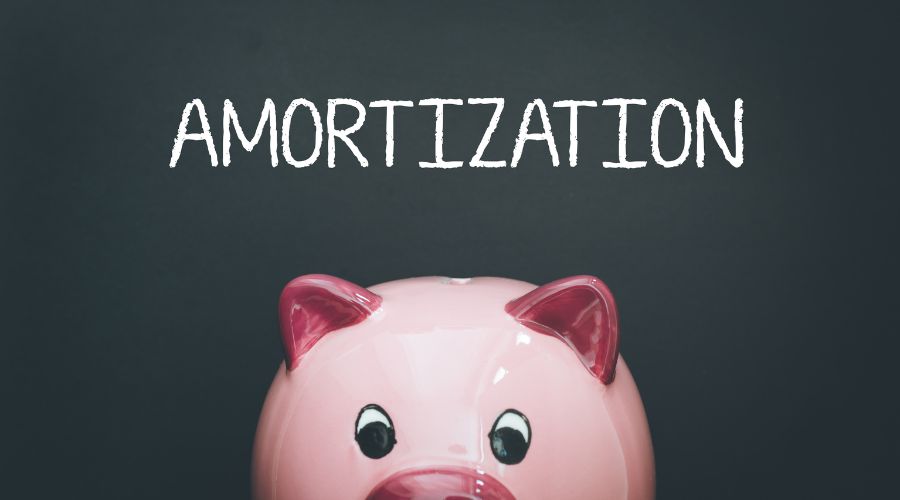Amortization is a financial term you may have come across while dealing with loans, mortgages, or other types of debt.
It is a method of assisting debtors in repaying their debt over time via a series of monthly installments.
Understanding amortization is important for both borrowers and investors because it affects financial planning and decision-making.
It enables borrowers to successfully manage their debts and may assist investors in evaluating the profitability of their investments.
Definition of Amortization
Amortization is the process of gradually reducing a debt or loan balance through regular payments that cover both the principal (the amount borrowed) and the interest accrued.
It also refers to the systematic allocation of the cost of an intangible asset over its useful life.
While both amortization and depreciation involve allocating costs over time, there’s a key difference between the two.
Amortization applies to intangible assets like patents and trademarks, while depreciation applies to tangible assets like machinery and buildings.
How Amortization Works
Amortization spreads the repayment of a loan or debt over a fixed period, making it more manageable for borrowers.
Each payment reduces the principal balance and covers the interest, eventually eliminating the debt.
An amortization schedule is a table that shows the breakdown of each payment into its components:
- Principal: The portion of the payment that reduces the outstanding loan balance.
- Interest: The cost of borrowing money, calculated based on the outstanding loan balance and interest rate.
- Monthly payment: The fixed amount paid each month, consisting of principal and interest.
Amortization affects the total interest paid over the life of the loan, with more interest paid at the beginning and less towards the end.
As the principal balance decreases, the interest portion of each payment also decreases, allowing more of the payment to go towards the principal.
Examples of Amortization
1. Amortized loans
Amortized loans are loans that require regular payments of principal and interest. Examples include:
- Fixed-rate mortgages: Home loans with a fixed interest rate and equal monthly payments for the life of the loan.
- Auto loans: Loans used to purchase a vehicle, typically with fixed interest rates and equal monthly payments.
- Personal loans: Unsecured loans for various purposes, repaid through fixed monthly payments.
2. Amortization of intangible assets
Amortization can also apply to intangible assets, spreading their cost over their useful life:
- Patents: Legal rights to an invention, amortized over their remaining legal life.
- Trademarks: Symbols or names representing a company or product, amortized over their useful life.
- Goodwill: The value of a company’s reputation, brand, or customer relationships, amortized over a set period.
Types of Amortizing Loans
1. Fixed-rate loans
Fixed-rate loans have an interest rate that remains constant for the life of the loan, resulting in predictable monthly payments.
2. Adjustable-rate loans
Adjustable-rate loans have interest rates that change periodically based on market conditions, which can result in varying monthly payments.
3. Interest-only loans
Interest-only loans require borrowers to pay only the interest for a set period, followed by principal and interest payments.
4. Graduated payment loans
Graduated payment loans start with lower monthly payments that increase over time, helping borrowers with lower initial incomes to afford the loan.
5. Balloon loans
Balloon loans have lower monthly payments during the loan term, but a large “balloon” payment is due at the end to pay off the remaining principal.
Credit and Loans That Aren’t Amortized
1. Credit cards
Credit card balances aren’t amortized, as they require only a minimum payment each month, which may not cover the full interest accrued.
2. Home equity lines of credit (HELOCs)
HELOCs are revolving lines of credit secured by your home, with variable interest rates and no fixed repayment schedule.
3. Payday loans
Payday loans are short-term, high-interest loans that don’t have an amortization schedule, as they’re typically due in full within a few weeks.
4. Bridge loans
Bridge loans are temporary, short-term loans used to cover immediate expenses, often without an amortization schedule.
Benefits of Amortization
1. Predictable monthly payments
Amortization allows for consistent monthly payments, making it easier for borrowers to budget and plan their finances.
2. Reduced risk of default
By spreading loan repayment over time, amortization reduces the risk of default by making payments more manageable.
3. Building equity
Amortization enables borrowers to build equity in their homes or other assets as they pay down the principal balance.
4. Interest savings through refinancing
Borrowers can save on interest by refinancing their amortized loans at lower interest rates or shorter loan terms.
5. Tax deductions (in some cases)
Interest paid on certain amortized loans, such as mortgages, may be tax-deductible, reducing the borrower’s overall tax burden.
Key Takeaways
Amortization is a crucial financial concept that affects loans, mortgages, and intangible assets.
It helps borrowers pay off their debt over time and allows investors to allocate costs over an asset’s useful life.
Understanding amortization is important for making informed financial decisions.
Conclusion
Understanding amortization is important for both borrowers and investors because it influences many elements of financial planning and decision-making.
You can efficiently manage your debts and make educated financial decisions if you understand how amortization works.
Amortization has many advantages, including regular payments, decreased default risk, and possible interest savings.
Borrowers may attain their financial objectives and investors can better monitor the profitability of their investments by using these benefits.








